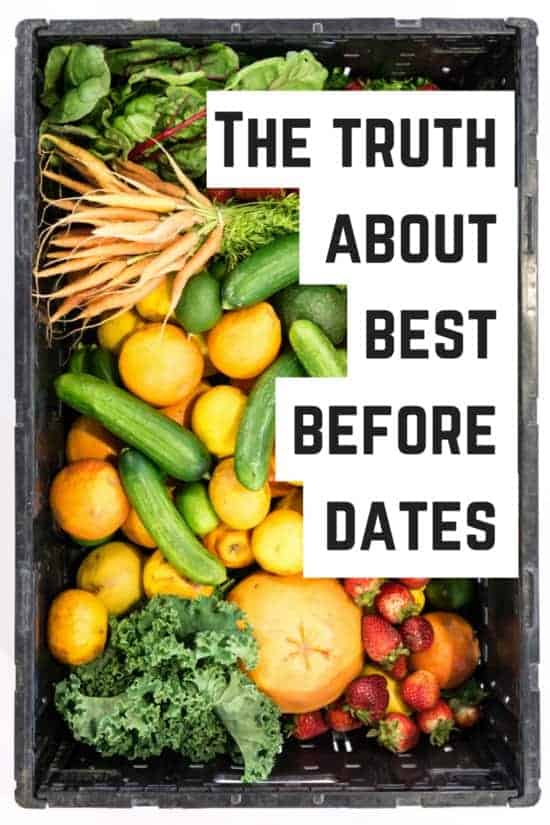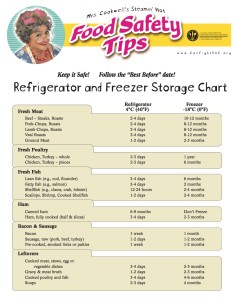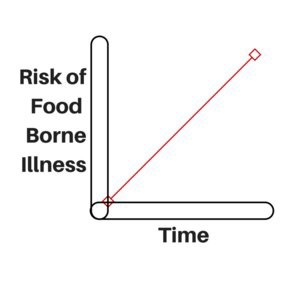
A Better Name: The Freshness Date
The best before date is a guideline. It’s actually better used as a freshness date instead of a safety date.
Once the best before date has come and gone:
- food quality decreases
- nutritional value may decrease as some vitamins degrade with time and exposure to air and light
- texture may be altered: crackers become stale, veggies go limp, fruit gets mushy
- separation of ingredients may occur
Once you open the package, the best before date is nullified. For example, if you purchase a package of cheese, it may have a best before date 10 months from now. But once you open the package and the cheese becomes exposed to the environment, the clock starts ticking on how long it will last before it goes mouldy…..about 3-4 weeks. Here’s a great storage chart. You can even print it out and tack it to your fridge or the inside of one of your cupboards for easy reference!
Best Before Date compared to Expiry Date
In Canada, there are a few foods that come with mandatory expiry dates:
- infant formula (human milk substitute)
- meal replacements (shakes, bars, etc)
- physician prescribed very low calorie diets (sold through a pharmacy)
- formulated liquid diets (for tube fed individuals)
NEVER eat or feed these foods to others after the expiry dates. These foods are designed to be nutritionally complete for the people they are made for. After the expiry date some of the nutrition is lost. These people may depend entirely on this food to meet their nutritional needs. A reduction in vitamins could make a big difference to these people! Additionally these foods are primarily for individuals who are at a vulnerable point in their lives:
- babies who have huge growth and developmental needs
- patients with medical conditions
- older adults with lowered immune systems
Risky Business
[blockquote cite=”Richard Wilson” type=”left”]The moment I climb out of bed I start taking risks. As I drowsily turn on the light I feel a tingle: my house is old with old wiring and there is a small risk of electrocution. Every year 500 people are electrocuted in the United States. I take a shower and as I reach for the soap, I wonder about the many chemicals it contains. Are they all good for the skin as the advertisement claims? My clothes have been cleaned with the best bleaching detergent. Most bleaches contain a chemical that fluoresces slightly in the sunlight to enhance the whiteness. Does this make bleaches carcinogenic? (Excerpt from Analyzing the Daily Risks of Life)[/blockquote]
Everything in life poses a certain amount of risk. There is no guarantee that a product is safe to consume before or after a best before date has passed. The risk of a food containing dangerous levels of illness causing bacteria, virus, mould, or yeast increases with storage time.
When it comes to the ‘best before’ dates on food the question is:
How much risk are you willing to take?
It’s impossible to tell if a food contains illness causing (pathogenic) organisms. None of the things you might think you can rely on (sight, smell, or taste) will actually tell you.
The mantra that you’ll hear over and over again is, “when in doubt, throw it out.”
Some people should play closer to the safe side:
- Babies
- Small children
- Pregnant women
- Older adults
- Immunocompromised individuals
These people are at a higher risk of getting sick by a smaller number of bacteria. Additionally, some food borne illnesses can have serious consequences for the unborn child.
Food Waste
The rates of food waste are staggering: it’s estimated that about 1/3 of food produced globally is lost or wasted. The main offenders are, unsurprisingly, the industrialized countries. The rate of waste is 10x higher in Europe and North America than in Sub-Saharan Africa and South/SouthEast Asia.
The encouraging part of all this is that YOU can do something about it. The statistics show that in Europe and North America, the BIGGEST losses occur due to consumer behaviour: a lot of food is thrown out even if it’s still okay to be eaten!
Tips to Prevent Food Waste
- Wash your fruits and veggies under running water. Scrub the peels of hard fruits and veggies. Vinegar or special fruit/veggie rinses are completely unnecessary. Most produce shouldn’t be washed in advance because that might remove a protective coating and could cause the produce to spoil prematurely. The exception is leafy greens such as lettuce and spinach.
- Know where and how to store your produce for maximum shelf/fridge life. This site has a VERY comprehensive guide!
- Clean your fridge regularly. Spoilage organisms produce spores that can become airborne, float, and land on other surfaces
- Cover your food in the fridge with containers that have lids or plastic wrap
When Can I Just Scrape the Mould Off?
Most moulds simply spoil the food but won’t make you sick. Some can make you very very sick. Unfortunately, you can’t tell by looking at a mould to know the difference. And please, don’t stick your nose in and smell the mould! You could inhale airborne particles, which could end up making you sick!
If you want to eliminate as much risk as possible, always throw the whole thing out. But if you’re okay with a small amount of risk, there are a couple of foods that you can cut the mould off and continue to eat the rest of the food. In the spirit of reducing food waste, I like to give people the option!
Mould needs a certain amount of moisture to grow. Hard foods may only provide the necessary amount of moisture on the surface. With these foods, the mould is unable to penetrate and grow deep roots. For these foods, you can cut off the mould plus 1 inch (2.5 cm) of the food. Make sure that the knife doesn’t touch the mould when you’re cutting. This could contaminate the rest of the food you’re planning on eating.
- hard cheeses (parmesan, cheddar, etc)
- hard veggies (carrots, broccoli, etc)
- hard crackers
Foods You Should Always Throw Out
- Dented cans… especially the ones that are dented on the seal. The bacteria (clostridium botulinum) that can grow in the can can produce fatal toxins.
- Soft foods with mould. These foods are soft enough for mould to grow deep, invisible roots: jams & jellies, peanut and other nut/seed butters, sauces, leftovers, soft cheeses, soft breads, deli meats, soft fruits (peaches, plums, bananas, etc), and soft veggies (cucumbers, tomatoes, etc.)
- Mouldy peanuts and nuts. These could contain aflatoxins, which can be fatal.
[share title=”Share This Article” facebook=”true” twitter=”true” google_plus=”true” linkedin=”true” pinterest=”true” reddit=”true” email=”true”]




I know so many people who freak out about “expiration” dates. I am very much a non-food waster so i can feel you there. Thanks for the great info!
Thanks for writing about this! It’s such an important topic! (Yay especially for those tips to prevent food waste! <3)